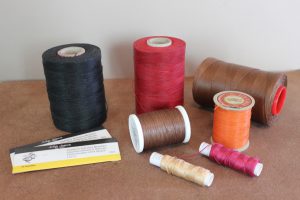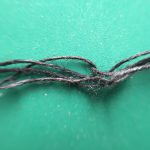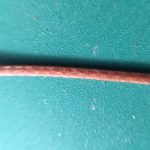Threads for leatherwork projects
 It seems everyone has their preferred choice of threads for hand stitching leatherwork projects, so here are some of the choices available….
It seems everyone has their preferred choice of threads for hand stitching leatherwork projects, so here are some of the choices available….
Traditional linen thread: A small colour range is available from Somac and in our opinion their thread is very strong. It comes waxed and the best choice of colours comes with the 18/3 cord. Usually available on small 50g spools. Coats Barbour produce the waxed machine linen thread too although this is also perfectly suitable for hand stitching. As with Somac, the 18/4, 18/5 and 18/6 cord tend to come in a limited range of three or four colours – usually black, brown and white…
Understanding the numbers:
What does the 3 represent in an 18/3?
Pictures 1 and 2 below show an 18/3 linen thread having been slightly loosened/untwisted. You can see it has three strands/ply.
Pictures 3 and 4 are of an 18/4 linen thread with the strands having been separated. You can see it has four ply.




What does the 18 represent?
The number 18 in this case, represents the thickness/gauge of the thread. We measured the 18/3 at 0.53mm. Measuring the 25/3 for example would give a lesser thickness as the lower the number, the thicker the thread, even though they are both 3 ply.
‘Au Chinois Lin Cable’ , or Cable Linen:


A French thread which we love not only because it is strong, hard wearing and luxurious, but also because of it’s colour range. It’s important that you buy the correct size thread for the task – We use a 432 or 332 for most med or large projects and an 832 for small leather goods. Cable Linen is a little more difficult to pierce the thread with the needle when locking the thread, but with a little practice it gets easier. Again, this thread appears to have a waxed finish to it although we always run it through beeswax before stitching. The pictures show an 18/3 linen thread (yellow) alongside a 332 Cable Linen (violet).
There is little difference between the two.
Tiger thread: Again, very strong but also very different from the threads mentioned above. It is a braided polyester thread which looks similar to a flat (not rounded) shoelace. It is difficult to taper – and perhaps then, unnecessary – but is not too difficult to feed through the eye of the needle anyway. It is available in different thicknesses with 1mm (Ritza 25) being approx’ equivalent to an 18/4 cord linen thread. You can see from the second picture (below) that there are at least 10 strands to this particular 1mm thread.


 Some silks can be used for stitching small items such as wallets and phone sleeves etc. However, it’s important to use a very strong silk such as buttonhole. A strong silk gimp is good too and has proven itself many times in the workshop. Our favourite is the 30/3 silk gimp from ‘Pipers Silks’. Again, the picture shows the three ply having been separated, hence the number. The advantage of using a strong silk over a 3/25 linen thread for example, is that there is an excellent colour range available in comparison. Also, the silk has a nice sheen to it which can look very smart when set against the leather. It is more manageable if run through the beeswax prior to stitching but expect the whole stitching process to be a little slower as it’s difficult to lock the ends of the thread over the needle. You may find too, that a small knot here and there may be needed as you finish your last few stitches.
Some silks can be used for stitching small items such as wallets and phone sleeves etc. However, it’s important to use a very strong silk such as buttonhole. A strong silk gimp is good too and has proven itself many times in the workshop. Our favourite is the 30/3 silk gimp from ‘Pipers Silks’. Again, the picture shows the three ply having been separated, hence the number. The advantage of using a strong silk over a 3/25 linen thread for example, is that there is an excellent colour range available in comparison. Also, the silk has a nice sheen to it which can look very smart when set against the leather. It is more manageable if run through the beeswax prior to stitching but expect the whole stitching process to be a little slower as it’s difficult to lock the ends of the thread over the needle. You may find too, that a small knot here and there may be needed as you finish your last few stitches.
What about needles? We use John James’ Harness Needles, size(s) 002, 003 0r 004 depending on the project, harness awl size and thread. 003 is a good all-rounder for a beginner.
Follow the link for the GDH Leather Courses videos on ‘How to Prepare a Thread’ and for How to Hand Stitch Leather: https://gdhleathercourses.co.uk/leather-training-videos/
Happy stitching!
